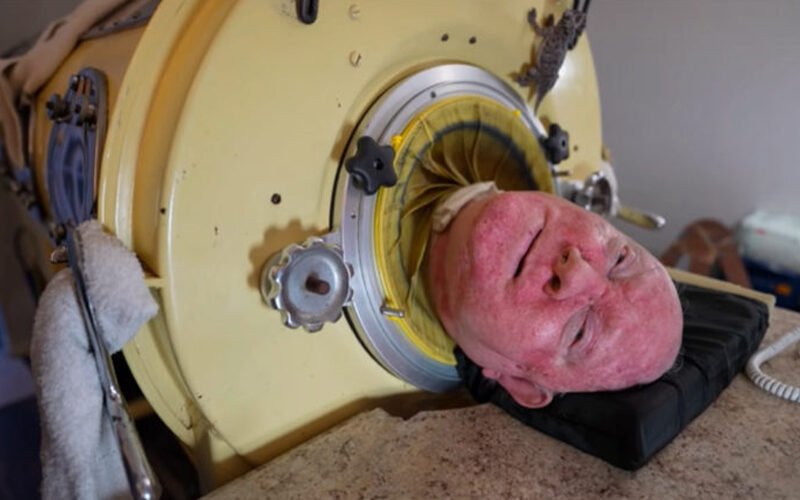Paul Alexander lived a life unlike many others. For the majority of his life, he’s was inside an iron lung, and he was one of the last people in the world still using the respirator which dates back to the 1928.
Despite his unusual circumstances, he’s lived an incredibly full life and he’s never accepted anything less.
“I am not going to accept from anybody their limitations on my life. Not gonna do it. My life is incredible.”

When Paul was six years old, he came running into his family’s home in a Dallas suburb, telling his mother he didn’t feel well. Born in 1946, Paul had always been a lively, active child but something was clearly wrong that day.
“Oh my God, not my son,” his mother said, as Paul later recalled.
Doctors advised bed rest, and Paul spent the next several days at home. But his condition quickly worsened. Within a week, he could no longer grip objects, swallow, or even breathe on his own.
His parents rushed him to the hospital, where he joined many other children suffering from similar symptoms—victims of a terrifying outbreak.
Before the polio vaccine became available, the virus paralyzed more than 15,000 people annually. Highly contagious, polio could spread even from those who showed no symptoms.
While some experienced only mild effects like fever, fatigue, and muscle pain, others like Paul—faced life-altering consequences, including paralysis and, in some cases, death.

A doctor initially examined Paul and pronounced him dead—but a second doctor wasn’t convinced. Acting quickly, he performed an emergency tracheotomy and placed Paul in an iron lung, giving him another chance at life.
When Paul regained consciousness three days later, he found himself surrounded by rows of children in the same machine.
“I didn’t know what had happened,” Paul recalled in a 2017 interview with As It Happens. “I had all kinds of imaginings—like I’d died. I kept asking myself: Is this what death is? Is this a coffin? Or have I gone to some undesirable place?”

Unable to speak due to the tracheotomy and completely paralyzed, Paul was terrified.
“I tried to move, but I couldn’t. Not even a finger. I tried to touch something to figure it out, but I never could. So it was pretty strange.”
The iron lung, first developed in the late 1920s and known early on as the “Drinker respirator,” was a revolutionary machine. It enclosed the body from the neck down in an airtight chamber and used negative pressure to draw air into the lungs—helping patients like Paul breathe when their muscles no longer could.

Paul spent 18 months inside the iron lung, recovering from the initial polio infection. He wasn’t alone—1952, the year he got sick, was one of the worst in U.S. history for polio. Nearly 58,000 people, most of them children, contracted the virus. Over 3,100 died.
“As far as you could see, rows and rows of iron lungs. Full of children,” Paul told The Guardian.
While many might have lost hope, Paul’s spirit only grew stronger. He often overheard doctors saying things like, “He’s going to die today” or “He shouldn’t still be alive.”
Each time, Paul made it his mission to prove them wrong.

And that’s exactly what Paul did.
In 1954, he was discharged from the hospital—but the world he returned to was far different than the one he’d known before.
“People didn’t like me very much back then,” he said in a 2021 video interview. “I felt like they were uncomfortable around me.”
Still, things slowly began to change thanks to a dedicated therapist named Mrs. Sullivan, who visited him twice a week. She made a deal with him: if he could “frog-breathe”—a technique where you gulp air by flattening your tongue and opening your throat—for three minutes without the iron lung, she’d get him a puppy.
It was a tough challenge, but Paul didn’t give up. Within a year, he was spending increasing amounts of time outside the machine.

At 21, Paul became the first person to graduate from a Dallas high school—with honors—without ever physically attending class. Then, he set his sights on college. After several rejections, he was finally admitted to Southern Methodist University.
“They said I was too crippled and hadn’t had the vaccine,” he recalled. “After two years of pushing, they let me in under two conditions: that I take the polio vaccine, and that a fraternity be responsible for me.”
Paul not only graduated from SMU, but went on to earn a law degree from the University of Texas at Austin. He passed the bar exam and built a career as a lawyer in the Dallas-Fort Worth area.
“And I was a pretty damn good one too,” he said proudly.
Paul Alexander’s Cause of Death
Paul Alexander, widely known as “The Man in the Iron Lung,” passed away in March 2024. Though he spent most of his life inside the metal machine that helped him breathe, he was remembered not for his condition—but for his strength, warmth, and unshakable spirit.
His brother, Philip Alexander, shared touching memories, calling Paul a “welcoming, warm person” whose “big smile” instantly made others feel at home.
“To me, he was just a normal brother,” Philip told the BBC. “We fought, we played, we loved, we partied, we went to concerts together—he was just a normal brother. I never thought about it.”
Philip also praised Paul’s remarkable independence and determination. “He was the master of his domain, helping people to help him,” he said, admiring how Paul maintained control over his life, even while relying on others for everyday tasks like eating.







